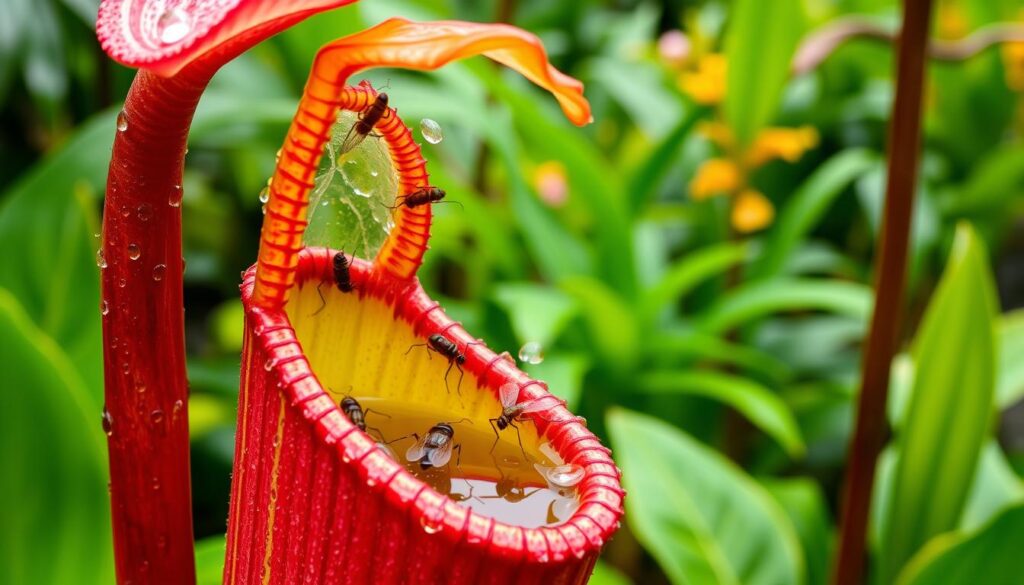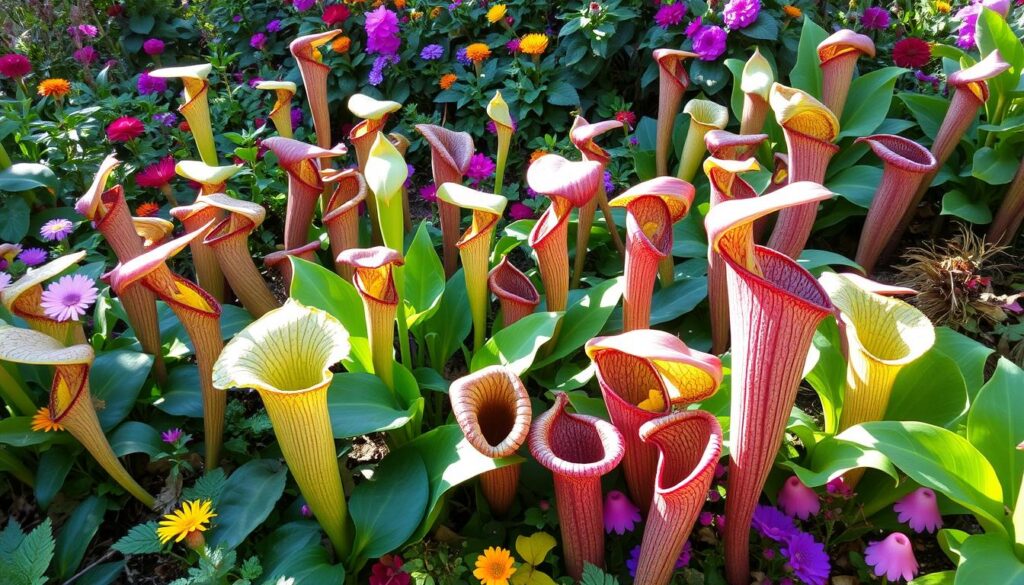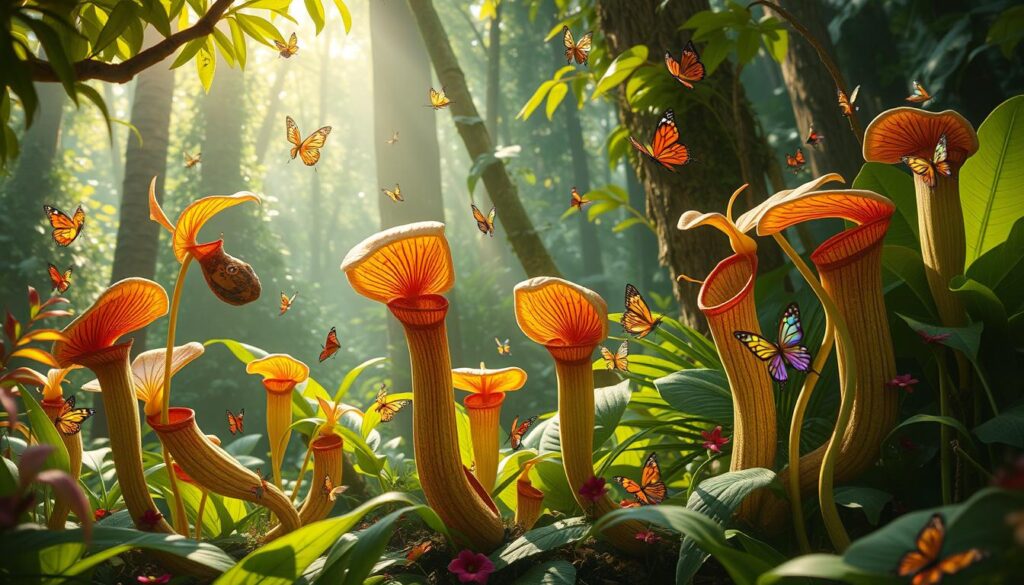The pitcher plant diet, representative of an intriguing aspect of carnivorous plants, showcases unique mechanisms for acquiring nutrients that differentiate these remarkable organisms from typical flora. This article will explore the ecological significance of pitcher plants and delve into their nutrient-gathering methodologies. In doing so, it will also examine their relevance in modern gardening practices and even culinary applications, illuminating how these plants thrive in environments where most vegetation cannot.
Table of Contents
Introduction to the Pitcher Plant Diet
The captivating world of pitcher plants offers a glimpse into the intricate survival mechanisms of carnivorous flora. These remarkable plants exhibit unique adaptations that allow them to thrive in nutrient-poor environments. Their specialized structures not only enable them to capture prey but also showcase a fascinating aspect of botanical evolution.
What is a Pitcher Plant?
Pitcher plants represent a remarkable group of carnivorous plants, each uniquely adapted to thrive in nutrient-poor environments by relying on their specialized pitcher plant diet. These plants use modified leaves to create pitfall traps, which resemble deep, liquid-filled cavities designed to attract and capture insects. Notable examples include tropical pitcher plants in the genus Nepenthes, with about 140 species native to regions like southeastern Asia and Australia. In contrast, the genus Sarracenia, found in eastern North America, comprises roughly 10 species that demonstrate adaptability to various wetland habitats.
Pitfall traps operate by enticing insects with sweet nectar and vibrant pigments. Once lured in, the slippery surface ensures the prey falls into the liquid, where escape is nearly impossible. This liquid helps digest the captured prey, providing essential nutrients to the plant. Interestingly, some pitcher plants, such as N. rajah, have taken their adaptations a step further by forming symbiotic relationships with animals, using their feces as an additional nutrient source. These unique adaptations showcase the ecological ingenuity of pitcher plants and their vital role in maintaining balance within their habitats.
Brief History of Carnivorous Plants
The study of carnivorous plants has roots reaching back to the 19th century, marked by Charles Darwin’s monograph published in 1875. His work highlighted the unique adaptations and trapping mechanisms of various species, revealing the sophistication found among these plants. Consequently, research has continued to uncover a rich tapestry of plant behaviors and habitats.
Approximately 630 species of carnivorous plants exist globally, each demonstrating various strategies to attract and digest prey. Many of these plants are adapted to thrive in environments characterized by poor soil, such as bogs and swamps, further emphasizing their evolutionary uniqueness.
How Pitcher Plants Obtain Nutrients
Pitcher plants exhibit a remarkable ability to procure essential nutrients through their unique feeding mechanisms. The intriguing world of these carnivorous plants showcases how they attract prey and effectively digest it, enabling them to thrive in nutrient-poor environments.
The Role of Attractants
To capture insects, pitcher plants employ a variety of enticing strategies. Many species produce sweet nectar, bright colors, or captivating odors, which draw potential prey towards their open mouths. This alluring nature significantly increases their chances of capturing insects, which are vital for their nutrient intake. A deeper understanding of what do pitcher plants eat reveals that their diet is mainly composed of insects that inadvertently fall into their specialized cavities.
Digestive Enzymes Explained
Once prey is captured, the digestion process begins. Pitcher plants release digestive enzymes that break down the soft tissues of the insects, allowing them to absorb vital nutrients. Research has indicated that Sarracenia species can process nutrients two to three times more efficiently than non-carnivorous counterparts. In particular, nitrogen and phosphorus from digested prey can provide as much as 50-70% of a Sarracenia plant’s nutrient intake. This adaptation proves essential, especially in acidic and nutrient-deficient soils where these plants often grow.

The effectiveness of this digestion is heightened by the absence of a waxy cuticle on the inner walls of Sarracenia pitchers. This feature facilitates increased nutrient absorption, enhancing their growth and overall health. By understanding how pitcher plants obtain nutrients, gardeners and plant enthusiasts can appreciate their fascinating role in the ecosystem.
| Species | Nutrient Acquisition Method | Digestive Efficiency |
|---|---|---|
| Sarracenia | Digestive enzymes | 2-3 times more than non-carnivorous plants |
| Nepenthes | Bacteria and enzymes | Varies by species |
| Cephalotus | Bacteria | Limited digestive efficiency |
Common Species of Pitcher Plants
Pitcher plants represent a unique group of carnivorous plants, each relying on their specialized pitcher plant diet to survive in nutrient-poor environments. Among the most notable are Nepenthes varieties and Sarracenia species, both displaying distinct traits perfectly suited to their habitats. Nepenthes, often called tropical pitcher plants, thrive in humid, forested regions, while Sarracenia, or North American pitcher plants, are adapted to boggy, temperate climates. Understanding these common pitcher plant species sheds light on their fascinating adaptations and highlights their ecological significance in maintaining balanced ecosystems.
Nepenthes: Tropical Variants
Nepenthes species primarily inhabit tropical regions, showing incredible diversity and adaptability. These plants utilize specialized leaf structures that form intricate pitcher traps, designed to catch various insects. The Nepenthean family consists of over 100 species, highlighting their evolutionary significance.
Some key features of Nepenthes include:
- Pitcher size: Varies significantly among different Nepenthes varieties.
- Trap design: Unique adaptations enhance their effectiveness in capturing prey.
- Habitat: Optimized for growth in humid, nutrient-poor conditions.
Sarracenia: Temperate Species
Sarracenia species, found in temperate regions, consist of several genera characterized by their ground-dwelling habitats. Notable members include Sarracenia purpurea, the floral emblem of Newfoundland and Labrador, Canada. This genus adapts well to local conditions, thriving in nutrient-deficient soils.
Highlighted aspects of Sarracenia include:
- Varieties: Includes about 10 species distributed across eastern North America.
- Habitat: Prefer bogs and wetlands, where they contribute to the ecosystem.
- Prey Capture: Use pitcher traps to digest insects and absorb vital nutrients.
Understanding these common pitcher plant species enriches knowledge of their ecological roles, adaptations, and the challenges they face in their habitats.
The Ecological Significance of Pitcher Plants
Pitcher plants hold substantial ecological importance in their habitats. Their specialized pitcher plant diet, which involves trapping and digesting insects, allows them to thrive in nutrient-poor environments where other plants struggle. These unique plants serve dual roles as both predators and habitats for diverse organisms. The presence of pitcher plants enriches pitcher plant ecosystems, facilitating nutrient cycling and supporting a variety of species. Their specialized adaptations create a microhabitat that sustains complex food webs, making them vital to the balance of these fragile ecosystems.
Habitat and Ecosystem Roles
Within bogs and wetlands, pitcher plants thrive and contribute to nutrient cycling. They create conditions that are vital for many organisms. The fluid within their pitchers not only offers a source of nutrients but also forms a community of microbes that assist in breaking down captured prey.
- Microhabitats: Pitcher plants provide a sheltered environment for various insects, often enhancing biodiversity.
- Nutrient Cycling: They play a critical role in recycling nitrogen, making them essential in nutrient-poor soils.
- Predatory Function: As active predators, they help control insect populations, fostering ecological balance.
Interactions with Insects
The relationship between pitcher plants and insects is fascinating. Predatory pitcher plants typically attract ants and other small insects, using both color and sweet nectar. Research has shown that pitcher plants captured a significant number of insects during experiments. Natural pitcher plants caught 357 insects, while artificial pitchers with sweet syrup attracted a comparable number, suggesting a sophisticated ecological interaction at play.
| Pitcher Type | Insects Captured |
|---|---|
| Natural Pitcher Plants | 357 |
| Pseudo-Pitchers with Sweet Syrup | 344 |
| Pseudo-Pitchers without Sweetener | 62 |
These findings highlight the ecological importance of pitcher plants in attracting prey, supporting food webs, and enhancing the biodiversity of their ecosystems. Such interactions underline not only the role of pitcher plants in their environment but also their necessity for various organisms relying on these unique habitats.
Nutritional Benefits of a Plant-Based Diet
Exploring the plant-based diet benefits reveals an array of key vitamins and minerals essential for overall health. This approach not only emphasizes the consumption of fruits and vegetables but also integrates fascinating elements of carnivorous plants, like the pitcher plant, into gardening. Nutrition from such plants provides dietary fiber, vitamin C, and folic acid, enhancing overall biodiversity and giving a rich variety to one’s diet.
Key Vitamins and Minerals
The nutritional advantages of plants extend far beyond basic sustenance. Key vitamins and minerals found in plants play vital roles in maintaining health, such as:
- Vitamin C: Supports immune function and promotes healthy skin.
- Folic Acid: Crucial for DNA synthesis and supporting cellular function.
- Fiber: Aids in digestion and helps in maintaining a healthy weight.
Integrating a diverse range of plant sources can lead to significant dietary improvements. For instance, incorporating pitcher plants in a garden setting not only captivates the interest of gardeners but also serves as a source of intriguing botanical knowledge while promoting health.
Environmental Impact of Plant-Based Diets
The adoption of a plant-based diet has far-reaching environmental implications. Research indicates that carnivorous plants, such as pitcher plants, thrive in nutrient-poor soils. They capture insects to obtain vital nutrients like nitrogen and potassium, enhancing soil presence without detrimental effects on the ecosystem. The minimal feeding requirements highlight their efficiency; usually, two to three feedings a year suffice for proper growth.
These findings emphasize the importance of embracing plant-based options, not only for personal health but also for environmental sustainability. For more insights, you can refer to in-depth studies on the nutritional benefits of various plant species.
How to Incorporate Pitcher Plant Elements
Incorporating pitcher plants into gardens and culinary experiences presents a unique opportunity for enthusiasts. Their intriguing pitcher plant diet, relying on trapping and digesting insects, makes them a natural pest control addition to any garden. These captivating species not only enhance garden aesthetics with their striking appearance but also offer culinary inspiration through their edible relatives, such as certain carnivorous plant species used in traditional recipes. Understanding the methods for successful integration will lead to a rewarding journey in gardening with pitcher plants and creatively exploring their connections to cooking.
Garden-Friendly Options
Integrating pitcher plants into a landscape requires mindful planning. These plants thrive in environments with high humidity and acidic soil. Some recommended practices for successful gardening with pitcher plants include:
- Choose species suitable for local climate conditions, with Nepenthes and Sarracenia being popular choices.
- Ensure the soil mix consists of 1 part peat to 1 part perlite or sand, promoting moisture retention.
- Opt for habitats that receive 6 to 8 hours of sunlight daily, in hardiness zones 10 to 12.
- Maintain humidity levels between 50% and 70% to mimic their natural tropical environments.
- Use distilled or rainwater for irrigation to avoid disrupting the plants’ digestion.
By following these guidelines, one can enjoy the aesthetic and ecological benefits of incorporating pitcher plants into their gardens while supporting local biodiversity.
Culinary Uses of Related Plants
Pitcher plants may not be directly used in cooking, as they are primarily carnivorous. However, related plants in the same botanical family can serve culinary purposes. Some examples include:
- Butterworts: Known for their attractive leaves, they can be used in garnishes.
- Sundews: Often used in teas for their health benefits.
- Many herbs: Plants like mint and basil complement dishes where pitcher plant aesthetics play a role.
Incorporating pitcher plants and their culinary relatives into garden designs and culinary presentations can offer both visual and flavor enhancements, making the journey of gardening with pitcher plants a fulfilling endeavor.

Pitcher Plants in Traditional Medicine
The significance of pitcher plants extends beyond their ecological roles. Their unique pitcher plant diet, which involves trapping and digesting insects, has always intrigued scientists and nature lovers alike. Additionally, various cultures have acknowledged the traditional uses of pitcher plants in herbal medicine. This recognition highlights humanity’s ancient relationship with nature and the unique properties of these fascinating plants, showcasing their importance not just in ecosystems but also in cultural history.
Cultural Significance
Across different regions, pitcher plants are viewed as more than just flora; they embody the wisdom embedded in traditional medicine. They often symbolize resilience and the rich tapestry of local cultures. Indigenous tribes have historically utilized pitcher plants not just for their ecological benefits but also for their perceived medicinal properties.
References in Herbal Remedies
Evidence exists that Native American tribes employed pitcher plants to treat a variety of health issues such as lower back pain, fever, chills, whooping cough, pneumonia, and kidney-related ailments. While the effectiveness of these herbal remedies varies, they underscore the importance of the plant in traditional therapies. Additionally, some tribes reportedly used pitcher plants for smallpox prevention, although documentation on this practice is less consistent.

Efforts such as prescribed burns help restore habitats by removing invasive species that threaten native forms. These actions are vital, especially since the unique pitcher plant diet depends on their ability to trap and digest insects, which can be impacted by invasive species. Timely interventions by botanists, like the transplantation of over 50 pitcher plants from construction sites, have demonstrated the significance of active conservation measures. The cooperation between organizations and governmental bodies reinforces the notion that pitcher plant conservation requires a united approach to protect these fascinating insect-eating plants.
Frequently Asked Question
What should I feed my pitcher plant?
Pitcher plants thrive on a diet of insects and other small prey. You can feed them ants, flies, small crickets, or even small spiders. The food should fit comfortably inside the trap without overwhelming it. Feeding every 2-4 weeks is sufficient if the plant isn’t catching bugs naturally.
Can I feed dead bugs to my pitcher plant?
Yes, you can feed dead bugs to your pitcher plant, but they must be fresh. Avoid dried or decayed insects, as these lack the moisture and nutrients the plant needs. If you’re feeding dead bugs, drop them directly into the liquid inside the pitcher for digestion.
Do pitcher plants like coffee grounds?
No, coffee grounds aren’t suitable for pitcher plants. These plants rely on nutrients from their prey rather than from the soil. Adding coffee grounds may harm their delicate roots or disrupt the soil’s pH balance.
How do I make my pitcher plant happy?
Provide bright, indirect sunlight and keep the soil moist but not waterlogged. Use distilled water or rainwater, as tap water can contain harmful minerals. Humidity levels around 50-70% are ideal, so misting the plant occasionally can help. Allow it to catch insects naturally if possible.
Can pitcher plants survive without insects?
Yes, pitcher plants can survive without insects, but they won’t thrive. Insects provide essential nutrients like nitrogen and phosphorus, which are crucial for healthy growth. Without prey, the plant may grow more slowly or produce fewer pitchers.
Can you feed pitcher plants mealworms?
Absolutely! Mealworms are an excellent food source for pitcher plants. Drop small pieces of mealworms into the pitcher traps to avoid overfeeding. Be cautious not to feed them too frequently to prevent mold or bacteria buildup inside the trap.

